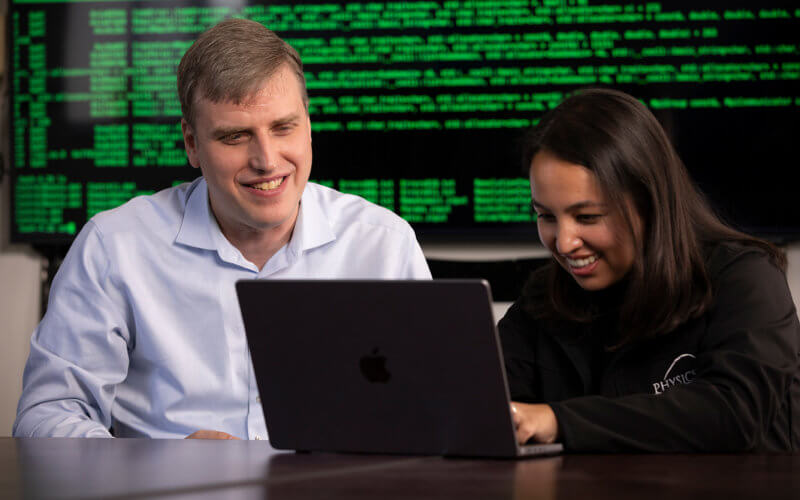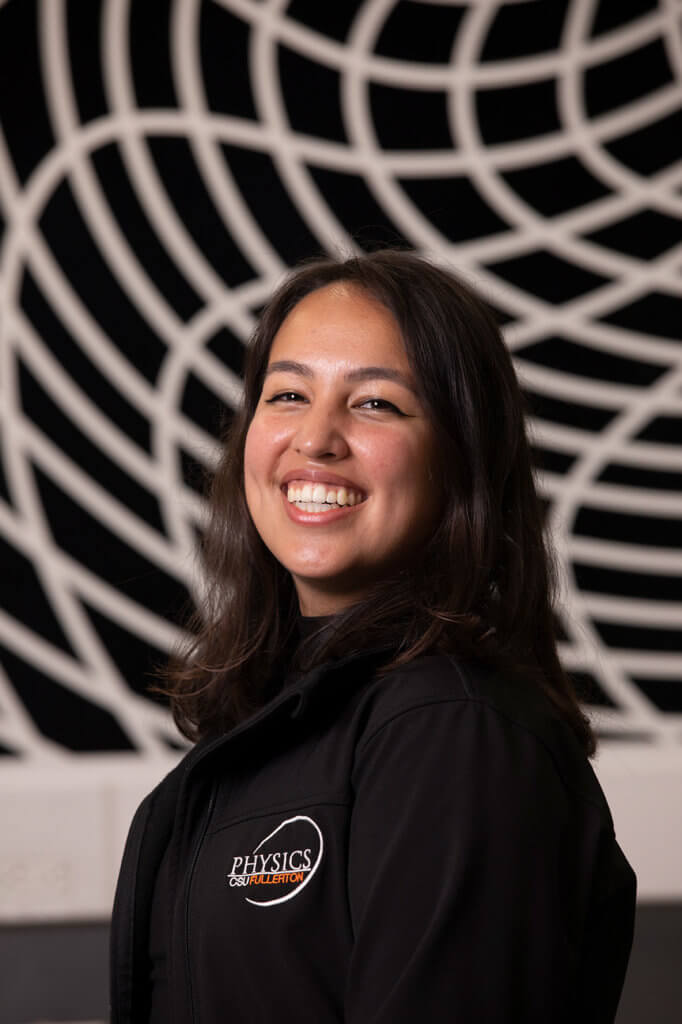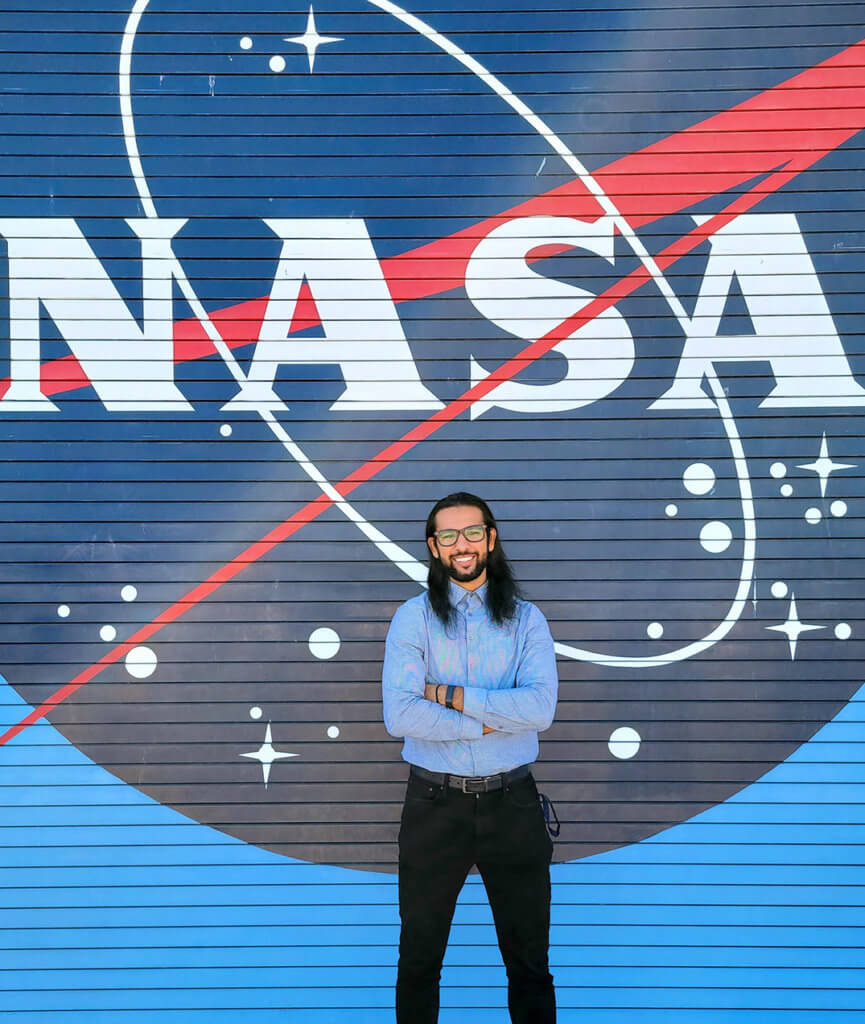
When alumni Haroon Khan and Denyz Melchor enrolled at Cal State Fullerton, neither expected to study black holes colliding billions of light years from Earth, resulting in ripples through the fabric of space-time known as gravitational waves.
“Black holes! They’re so cool. Everything about space has always fascinated me since I was a kid,” said Khan, a NASA engineer. “I realized that the more we learn, the less we realize we know about space.”
Melchor had no idea that black holes, a cosmic body so powerful that nothing, not even light can escape, really existed in the universe — that is, until she joined the Nicholas and Lee Begovich Center for Gravitational-Wave Physics and Astronomy (GWPAC).
“They are very science fiction and I wondered how they could be real. Light goes in but can’t come out,” said Melchor, now a doctoral student studying astronomy and astrophysics at UCLA.
Khan and Melchor are examples of GWPAC alumni whose curiosity about the cosmos led them to study gravitational-wave science at CSUF. For a decade, the campus center has fostered research, education and outreach in gravitational-wave astronomy, physics and astrophysics.
Faculty, students, alumni and donors celebrated the center’s 10-year anniversary on Sept. 30 with a scientific meeting and Oct. 1 alumni event.
GWPAC is led by Joshua Smith, professor of physics and Dan Black Director of Gravitational-Wave Physics and Astronomy; Jocelyn Read, associate professor of physics; Geoffrey Lovelace, professor of physics; and Alfonso Agnew, chair and professor of mathematics.

“The most exciting part of going to the GWPAC anniversary event was having my mom with me to hear how hardworking I was as a CSUF student,” said Melchor. “She was brimming with pride when Dr. Lovelace sat with us to tell her how proud he was of my accomplishments. Immediately after the celebration, she called my dad to gush about it all, who was equally as proud.”
Over the last decade, more than 50 GWPAC student researchers have graduated from Cal State Fullerton. About half entered or completed doctoral programs and the remainder have pursued STEM professions or teaching careers.
Khan ’17 (B.S. electrical engineering, minor in physics) relayed that GWPAC exposed him to opportunities in the scientific world, where he worked on simulating binary black hole collisions and created visualizations.
“Prior to learning about GWPAC, I had no idea about undergraduate research and the doors that it would open,” he said.
Khan works at NASA’s Ames Research Center in Silicon Valley as lead electrical engineer on the Vertical Motion Simulator, a NASA critical simulator used to develop new aircraft and spacecraft, and to train astronauts. Khan also has worked on NASA’s Artemis Mission to return astronauts to the lunar surface.

“Studying gravitational-wave science changed my life in multiple ways. First, it taught me how to conduct cutting-edge research with collaborators from around the world,” said Khan, who is working on a master’s degree in astronautical engineering at USC.
“I also learned math, physics, programming, and presenting and technical skills that I would not have learned in my classes. I believe that being a researcher in GWPAC directly led to my employment at NASA — my childhood dream.”
Melchor ’20 (B.S. physics) is a first-generation college graduate whose parents immigrated from Mexico. She was awarded numerous scholarships, including a 2019 Barry Goldwater Scholar award and a National Science Foundation Graduate Research Fellowship, which helped make graduate school possible.
These accolades, along with her undergraduate research at GWPAC, Monash University in Australia and Cornell University in New York propelled her on a path to earn a doctorate. She also participated in programs for underrepresented students, including the McNair Scholars Program, and co-authored publications.
Melchor’s career goal is to teach and work in research at a university and mentor first-generation college students like herself.
Both Khan and Melchor credit the mentorship and support of GWPAC faculty members for helping them realize their academic and career goals.
“They empowered me to feel like I can succeed,” said Melchor, whose current research focuses on the dynamics of stars near supermassive black hole binaries.
“I’m really proud of what I have achieved — and what I will achieve.”
GWPAC Researchers Contribute to Cosmic Discoveries
Back in 2012 with the grand opening of GWPAC, which included speakers such as renowned theoretical physicist and 2017 Nobel laureate Kip Thorne of Caltech, the success of the center was not guaranteed. After all, Albert Einstein himself predicted that the gravitational waves produced by colliding black holes and neutron stars would be too small to detect.
“Yet, these measurements were made and our GWPAC faculty and students played a leading role in these most thrilling of discoveries,” said Marie Johnson, dean of the College of Natural Sciences and Mathematics, during her remarks at the scientific meeting.
Since the first discovery in 2015, GWPAC faculty members and students have contributed to 90 gravitational-wave events from merging black holes and neutron stars, and developed techniques and technologies to advance the field of gravitational-wave science.
“Together, our faculty members envisioned, created and sustained something wonderful right here at Cal State Fullerton,” Johnson added. “With all their amazing scientific contributions, what these professors are most proud of is the success of our GWPAC students. The center, through significant federal and philanthropic support, has provided outstanding opportunities for these students.”